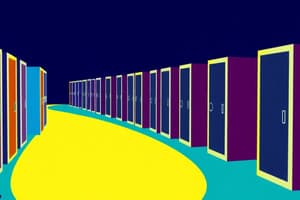Podcast
Questions and Answers
Which type of computer is primarily designed for portability and general computing tasks?
Which type of computer is primarily designed for portability and general computing tasks?
- Mainframe
- Supercomputer
- Workstation
- Laptop (correct)
What is a key distinguishing feature of a workstation compared to a personal computer?
What is a key distinguishing feature of a workstation compared to a personal computer?
- General use for common tasks
- Smaller size and portability
- Higher processing power and specialized hardware (correct)
- Lower cost and simplicity
Which category of computers is primarily used by large organizations for handling heavy transaction processing and managing large databases?
Which category of computers is primarily used by large organizations for handling heavy transaction processing and managing large databases?
- Personal Digital Assistant
- Workstation
- Personal Computer
- Mainframe (correct)
Which of these computer types is known for its ability to perform complex scientific and engineering calculations at very high speeds?
Which of these computer types is known for its ability to perform complex scientific and engineering calculations at very high speeds?
What was the primary function of Personal Digital Assistants (PDAs) before smartphones became widespread?
What was the primary function of Personal Digital Assistants (PDAs) before smartphones became widespread?
Which of these statements best describes a key characteristic of a personal computer (PC)?
Which of these statements best describes a key characteristic of a personal computer (PC)?
Which of the following computer types is the smallest and has limited processing power?
Which of the following computer types is the smallest and has limited processing power?
Which type of computer is designed for tasks that require higher processing power than a typical personal computer or laptop, such as video editing and graphic design?
Which type of computer is designed for tasks that require higher processing power than a typical personal computer or laptop, such as video editing and graphic design?
Flashcards
Personal Digital Assistants (PDAs)
Personal Digital Assistants (PDAs)
Small, handheld devices with limited processing power. Primarily used for organizing and retrieving data. Modern smartphones have largely replaced them.
Personal Computers (PCs)
Personal Computers (PCs)
Most common type of computer, designed for individual use. They are powerful enough for tasks like word processing, web browsing, and gaming.
Laptops (or Notebooks)
Laptops (or Notebooks)
Portable computers with similar processing power to PCs, designed for easy transport. They are becoming increasingly powerful and versatile.
Workstations
Workstations
Signup and view all the flashcards
Mainframes
Mainframes
Signup and view all the flashcards
Supercomputers
Supercomputers
Signup and view all the flashcards
Types of Computers by Size: Not Absolute
Types of Computers by Size: Not Absolute
Signup and view all the flashcards
PCs and Add-ons
PCs and Add-ons
Signup and view all the flashcards
Study Notes
Types of Computers by Size
-
Computers vary in size and capabilities. Advancements blur the lines between types. General classifications illustrate differences in usage and power.
-
Personal Digital Assistants (PDAs): Small, handheld devices. Early models had limited processing but stored, organized, and retrieved data. Modern smartphones largely replace PDAs. Key features included small screens, limited storage, and specialized apps.
-
Personal Computers (PCs): Common type for individuals, from desktops (tower) to all-in-ones. PCs have a tower or desktop housing. They handle tasks like word processing, internet access, gaming, and general computing. PCs have a wider range of add-ons (upgrades to hard drive, graphics cards) and vary in power and storage. PCs are typically programmed for general tasks.
-
Laptops (or Notebooks): Portable computers, combining PC processing power in a smaller form factor. Laptops are increasingly sophisticated with higher resolution screens, better processing, and more storage. Portability is a key advantage over desktops.
-
Workstations: Specialized computers for demanding tasks (graphic design, video editing, scientific simulations). Workstations are typically faster, have more powerful processors, better graphics cards, ample memory, and storage. They are suitable for professions needing higher processing power compared to PCs or laptops.
-
Mainframes: Large, powerful computers for heavy processing loads in large organizations. They manage tasks such as transaction processing, data warehousing, and complex applications for massive databases. Mainframes have extremely high processing power and many supporting peripherals (e.g., large storage for multiple computers, huge data).
-
Supercomputers: Most powerful computers. Used for complex scientific/engineering applications. Solve complex problems (weather forecasting, drug discovery, nuclear research). Supercomputers have extremely high computing power and storage, often using thousands of processors working together.
Studying That Suits You
Use AI to generate personalized quizzes and flashcards to suit your learning preferences.




